There is only so much information that can be obtained by studying the layers of paint in a room:
a) the colours used (obviously);
b) the pigments employed – and occasionally therefore a clue to the dating of individual schemes;
c) the fact that certain elements might have fewer layers than others – suggesting that they are later additions;
d) the use of paint effects such as marbling or graining.
Having made a study of the methods and materials of the housepainter one can begin to read a lot more into the paint layers – notably the period when particular techniques were used; the result of colour combinations and their significance, and the coming and going of fashions.
However, it is when that information is combined with a study of surviving documentation and images that big chunks of the jigsaw can be completed and paint analysis can become a serious archaeological tool.

A good example of this ‘team effort’ was experienced recently at the Grade I Fawley Court, in Buckinghamshire. Having identified the sequence of paint layers on the different elements of the Entrance Hall, I was provided with extracts of the documents that survived in the Buckinghamshire and Gloucester Archives.
One such clue appeared in the diaries of Caroline Powys of Hardwick, the wife of Philip Lybbe Powys and usually referred to as Mrs Lybbe Powys. A gentlewoman by birth and married to a member of the landed gentry she leaves an account of her visits to many houses in the last quarter of the 18th century.
In 1771 Mrs Lybbe Powys described the hall at Fawley Court as being:
“stucco’d of a French grey.”1
When I re-examined the paint stratigraphy on the lower wall there was, as the fifth scheme, a pale bluish grey that was the only one that could be described as such.
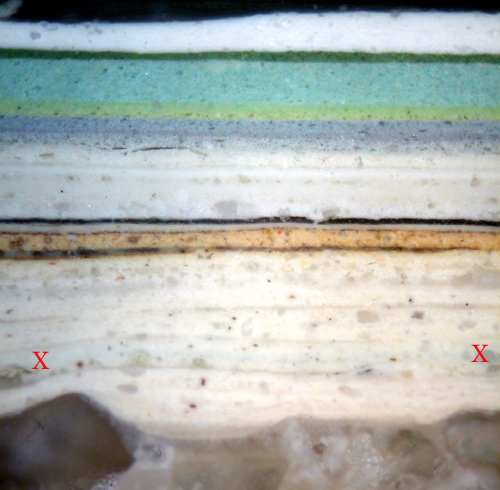
French Grey layer marked with “X”
On closer examination it could be seen that the colour was achieved by the addition of the pigments Prussian blue, vermilion and a little charcoal black to the lead white base of the oil paint. As will be seen this was a ‘classic’ recipe for French grey. This enabled me to date the fifth scheme to ca.1770 and with a few other clues that were unearthed I was able to date most of the twenty schemes applied in that room and, as a result, date the ornate plaster ceiling and cornice, the joinery and the sash windows. (Obviously, having dated the windows, this meant that I already had a useful clue in other rooms in the house.)
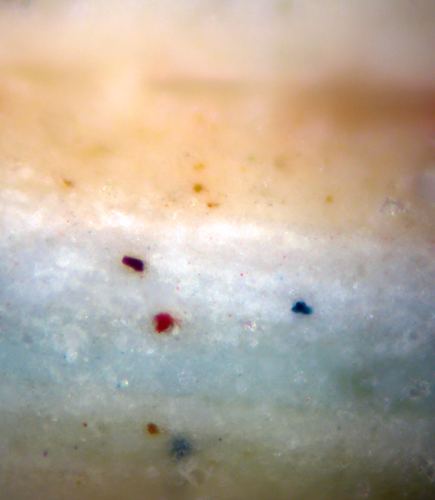
Now French Grey as a colour name is rather like Pea Green – a colour that will immediately register with most people. However, when asked to describe it the responses will be varied. What does it look like?
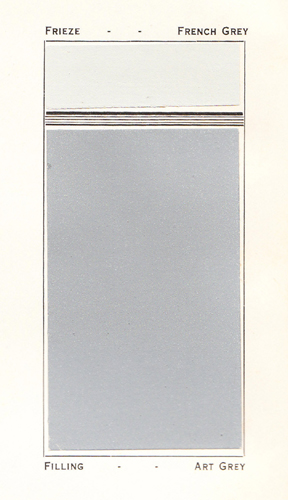
Formulation
French Grey is quite distinctive when examined under the microscope as it invariably contains blue and red pigments, sometimes with black.
A 19th century update of the original English housepainting manual (John Smith’s The Art of Painting) gives the following instructions for mixing French Grey:
“Take white lead and Prussian blue, or blue verditer; and, to make a more beautiful and pleasant colour, take a small quantity of Lake or Vermilion”3
In another work we are told that:
“French Grey should neither be dark nor yet too light, but a middle tint.”4
Although using a different red pigment and not mentioning the addition of black the same early nineteenth recipe suggests adding:
“as much ground Prussian blue as shall make it to your mind, then add as much Lake, or Rose Pink, as will bestow on it a faint bloom.”5
Use of French Grey
French Grey crops up frequently as a name in accounts of the late 18th and early 19th centuries. For example:
In the 1760s the bill for the painting of the hall at Osterley Park specifies that it was done in white and French Grey with the trophy panels
“minutely pick’d in with three tints of grey.”
In 1772 the walls of the Dining Room at Gordon Castle were painted in French grey.
A near-contemporary account of French Grey in use was in the Venetian Parlour of the Mansion House, where it was employed at 8d a yard in 1779.6
Sir John Soane had specified the use of the colour at Letton Hall, his first country house in 1792:
French grey in breakfast parlour, best staircase passages, attics, housekeeper’s room and store room.
It was always a special or “fancy” colour and one whose use would incur a small surcharge on the painter’s bill.
French grey still appeared on paint colour cards of the early 20th century, but some manufacturers seem to have interpreted it as a darker more green grey than was originally implied. It was one of the 64 colours that appeared in the first revised range of British Standard colours (BS381C) of 1931 as colour No. 30. An example of this colour in a later edition of this card can be seen below.

The next British Standard range, BS2660 was introduced in 1955. Although the numbers given to the colours were the same regardless of the manufacturer of the paint, the paint-makers each allocated their own names. Here, for example is colour 4-049, which was called Eddystone by Dulux, but French grey by Leyland.

In the early 1990s I was employed by English Heritage to produce a range of paint colours, each with historical precedent. Needless to say, French grey was one of the ones that I chose. Having mixed paints to the early 19th century recipes I then colour-matched them and the range was released as the Dulux Heritage range. A similar exercise was carried out with English Heritage and the Little Greene Company in recent years and these colours are called Colours of England.7
As an aside I have been reminded that the plastron8 of the tunics of the 21st Lancers (Empress of India’s) were laid down as French Grey.9
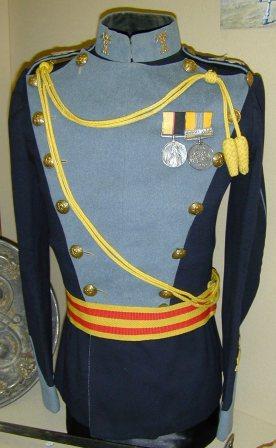
Notes
For a discussion of “Grey” and “Gray” see – The Pefect Grey
1 Emily J. Cleminson (ed.). Passages from the Diary of Mrs Lybbe Powys. 1899, 146).
2 Arthur Seymour Jennings. The Decoration and Renovation of the Home. 1924. Combinol Flat Oil paint was produced by Messrs. Goodlass, Wall & Co.
3 W. Butcher. Smith’s Art of House-Painting. 1821, 26.
4 T.H. Vanherman. Every Man his own House-painter and Colourman. 1829, 38.
5 (ibid.).
6 It is interesting to note that the same price was being charged in 1818. The same source indicates that a Common Colour such as Lead, Stone, Chocolate, or White was charged at 5d per yard. (W.R. Laxton. The Improved Builders’ Price Book. 1818, 96).
7 Unfortunately, both manufacturers have altered the ranges from what I originally produced and I have had to withdraw my unqualified support for them.
8 The breast covering of a lancer’s tunic.
9 With thanks to Dr Dan Jackson for pointing this out and to The Queen’s Royal Lancers and Nottinghamshire Yeomanry Museum for the image.
You can read a slightly different version of this in The Anatomy of Colour, published by Thames & Hudson and available from John Sandoe (Books).
View Larger Map


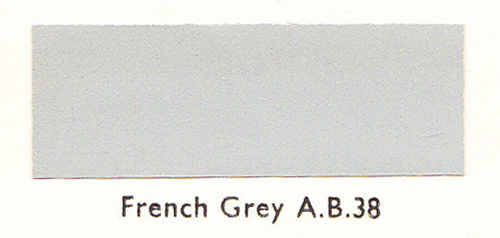










Removing paint from cornices at the Dockmaster’s House, Sheerness Docks, I have come across a grey layer in one of the rooms. I am attempting to leave coatings at and below a red distemper layer, and the grey is above this. The grey can be distinguished from a soot layer at the fireplace end by its lightness and evenness of tone.
It would be interesting to see the full stratigraphy.
I will try to take off a couple of complete sections.